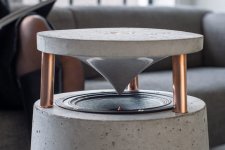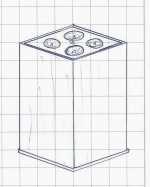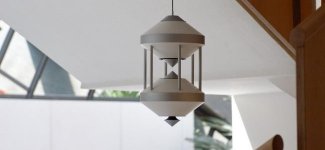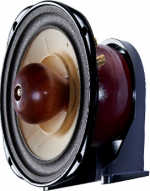Stuck in my head, input needed
You might find this post interesting if:
- You like thinking about creative solutions for unconventional problems;
- You like unconventional box designs;
- You like more questions than answers;
- You like my weird thinking;
- You like long posts.
Designing the system of my dreams. I want to walk around the room and not deal with phase cancellation or beaming issues. My ideal speakers sound good at any listening position, can play loud, feel like they're 'breathing', and have an immersive and encompassing quality to them. I have boggled it down to some more concrete requirements. Please bear with me as my convoluted brain processes unfold themselves.
My demands:
- Full range system
- Response 40Hz to 8kHz
- Ability to fill 50m³ room (1766 cubic feet)
- Ability to play loud
- Omnidirectional sound dispersion
Let's break those down!
Full range: Self-explanatory. Definitely no crossover.
Response 40 to 8kHz: Okay, perhaps not full full range... I will be adding in biamped supertweeters (sue me!), but I have all that figured out already. These boxes will be run full range without crossover, and 40-8kHz is what they have to cover. I'm asking your help regarding solely these boxes that will be run full range.
Ability to fill room: 50 cubic meters at least, preferably more. The boxes will have to be able to do this without effort.
Ability to play loud: Sometimes I play metal music loudly and then I don't care much about the audiophile characteristics. Often I will turn down the bass frequencies to take some strain off the drivers. That said, I'm probably wanting drivers with above average Xmax, say 3-5mm (about 1/8th inch - 3/16th inch)
Omnidirectional sound dispersion: Here the interesting part begins!
Traditional omnidirectional speaker designs make use of an upward firing driver that shoots audio into a waveguide of sorts, usually a concave cone that reflects audio 360° [attachment 1]. The sound heard would be the sound that is reflected off the waveguide. Unfortunately, this leads to some loss of sensitivity (compared to the point-source measurements supplied by the manufacturer). A driver that is listed as 96dB/m (1W) will most likely measure around 93dB/m when integrated in this traditional omnidirectional box design. (Correct me if I'm wrong.) Loud full range drivers are rare to begin with, so losing sensitivity is tough when my other requirement is for these speakers to play loud.
This introduces some unconventional restrictions on the box design. For the last months, I have been weighing the pros and cons of two options:
- Upward firing driver into a flared conical waveguide [attachment 1]
- Multiple smaller drivers shooting upward into the air [attachment 2]
Let's break it down.
Option 1 - Upward firing driver into waveguide: This is the traditional omnidirectional design. I would want a high-sensitivity driver with a stiff cone that can handle about 40 Watts nominal, and has about 3-5mm Xmax. How about that for asking for the impossible…
Though I do think I would have some options here. For example, the Tangband W8-1808 is rated 93dB/m and 30W nominal, while having a stiff bamboo cone and an Xmax of 5mm (about 3/16th inch). Firing this driver upward into a concave cone might still yield ~92dB/m in the upper midrange and about 90dB/m in the lower midrange/upper bass. Combined with a bass reflex, extension to 40Hz could perhaps still be about 89dB/m, which is not unreasonable, if one considers all my demands. (These are educated guesses.) Often I turn down the bass a little bit when I crank up the total volume, so the driver should be able to play anything above 120Hz or so even louder, whilst the decreased bass in the input signal and a not-very-low Qts cause the conus to stay inside the Xmax boundaries. Extending a little outside of the Xmax when cranked is not a problem IMO.
While I think this design would be possible, it does greatly reduce my options regarding driver choice: not many drivers meet the required specifications. I think most drivers that remain are about 8"-10"-12" in diameter and will have to be cone-treated to ameliorate cone breakup issues. Beaming is not much of an issue because of the waveguide.
( In case of the Tangband: 100L ported box (about 3½ cubic feet) tuned to 40Hz. )
Option 2 - Multiple drivers firing upward: Another way to achieve omnidirectional sound dispersion is by having a driver fire upward. The sound you hear then is for the greatest part reflected sound from adjacent walls, and also the ceiling. This design is tried and tested and works great for omnidirectional sound dispersion, but has downsides. Having the driver fire up into the air greatly reduces perceived sensitivity at the point of listening (3dB/m at least, most likely more), since most waves hit the ceiling and the walls before they reach the ear. However, since no waveguide is hanging above the driver, it is possible to multiply the amount of drivers. For example, one could have 4 full range drivers firing upward in order to achieve omnidirectional sound. This would in turn lead to a higher total system sensitivity and a lower required Xmax per driver. Think of it like an upward-firing driver array… that eliminates comb-filtering because of its dispersion pattern. However, since beaming is a thing, smaller drivers would be required in order to achieve pleasant omnidirectional sound dispersion. Luckily, since there are a lot of small-ish full-range drivers (4" or so) out there, a lot more drivers that fit the specs remain as an option.
Other options that I have ruled out:
Angled bipoles: Nope I don't want the large dead spot down the middle
Angled dipoles: Too much drop in efficiency, especially in the bass
OB dipoles out in the room: Don't have enough space in my room to make those truly viable
So, according to my rationale, I'm stuck at a fork in the road, having to choose between the two options listed above. Even though I'm having tunnelvision and I'm missing lots of stuff, I would still like to compare these two options here. I find it hard to imagine whether they would satisfy my demands. I also find it hard to weigh their pros and cons in relation to the ideal that I have in my head.
Therefore I'm curious to your thoughts regarding the two options that I listed.
- Do you think either would satisfy my demands?
- Would you specifically advise against one of the two?
- Do you have experience with either option? Please share.
(Be kind!)
Cheers,
Raoul
You might find this post interesting if:
- You like thinking about creative solutions for unconventional problems;
- You like unconventional box designs;
- You like more questions than answers;
- You like my weird thinking;
- You like long posts.
Designing the system of my dreams. I want to walk around the room and not deal with phase cancellation or beaming issues. My ideal speakers sound good at any listening position, can play loud, feel like they're 'breathing', and have an immersive and encompassing quality to them. I have boggled it down to some more concrete requirements. Please bear with me as my convoluted brain processes unfold themselves.
My demands:
- Full range system
- Response 40Hz to 8kHz
- Ability to fill 50m³ room (1766 cubic feet)
- Ability to play loud
- Omnidirectional sound dispersion
Let's break those down!
Full range: Self-explanatory. Definitely no crossover.
Response 40 to 8kHz: Okay, perhaps not full full range... I will be adding in biamped supertweeters (sue me!), but I have all that figured out already. These boxes will be run full range without crossover, and 40-8kHz is what they have to cover. I'm asking your help regarding solely these boxes that will be run full range.
Ability to fill room: 50 cubic meters at least, preferably more. The boxes will have to be able to do this without effort.
Ability to play loud: Sometimes I play metal music loudly and then I don't care much about the audiophile characteristics. Often I will turn down the bass frequencies to take some strain off the drivers. That said, I'm probably wanting drivers with above average Xmax, say 3-5mm (about 1/8th inch - 3/16th inch)
Omnidirectional sound dispersion: Here the interesting part begins!
Traditional omnidirectional speaker designs make use of an upward firing driver that shoots audio into a waveguide of sorts, usually a concave cone that reflects audio 360° [attachment 1]. The sound heard would be the sound that is reflected off the waveguide. Unfortunately, this leads to some loss of sensitivity (compared to the point-source measurements supplied by the manufacturer). A driver that is listed as 96dB/m (1W) will most likely measure around 93dB/m when integrated in this traditional omnidirectional box design. (Correct me if I'm wrong.) Loud full range drivers are rare to begin with, so losing sensitivity is tough when my other requirement is for these speakers to play loud.
This introduces some unconventional restrictions on the box design. For the last months, I have been weighing the pros and cons of two options:
- Upward firing driver into a flared conical waveguide [attachment 1]
- Multiple smaller drivers shooting upward into the air [attachment 2]
Let's break it down.
Option 1 - Upward firing driver into waveguide: This is the traditional omnidirectional design. I would want a high-sensitivity driver with a stiff cone that can handle about 40 Watts nominal, and has about 3-5mm Xmax. How about that for asking for the impossible…
Though I do think I would have some options here. For example, the Tangband W8-1808 is rated 93dB/m and 30W nominal, while having a stiff bamboo cone and an Xmax of 5mm (about 3/16th inch). Firing this driver upward into a concave cone might still yield ~92dB/m in the upper midrange and about 90dB/m in the lower midrange/upper bass. Combined with a bass reflex, extension to 40Hz could perhaps still be about 89dB/m, which is not unreasonable, if one considers all my demands. (These are educated guesses.) Often I turn down the bass a little bit when I crank up the total volume, so the driver should be able to play anything above 120Hz or so even louder, whilst the decreased bass in the input signal and a not-very-low Qts cause the conus to stay inside the Xmax boundaries. Extending a little outside of the Xmax when cranked is not a problem IMO.
While I think this design would be possible, it does greatly reduce my options regarding driver choice: not many drivers meet the required specifications. I think most drivers that remain are about 8"-10"-12" in diameter and will have to be cone-treated to ameliorate cone breakup issues. Beaming is not much of an issue because of the waveguide.
( In case of the Tangband: 100L ported box (about 3½ cubic feet) tuned to 40Hz. )
Option 2 - Multiple drivers firing upward: Another way to achieve omnidirectional sound dispersion is by having a driver fire upward. The sound you hear then is for the greatest part reflected sound from adjacent walls, and also the ceiling. This design is tried and tested and works great for omnidirectional sound dispersion, but has downsides. Having the driver fire up into the air greatly reduces perceived sensitivity at the point of listening (3dB/m at least, most likely more), since most waves hit the ceiling and the walls before they reach the ear. However, since no waveguide is hanging above the driver, it is possible to multiply the amount of drivers. For example, one could have 4 full range drivers firing upward in order to achieve omnidirectional sound. This would in turn lead to a higher total system sensitivity and a lower required Xmax per driver. Think of it like an upward-firing driver array… that eliminates comb-filtering because of its dispersion pattern. However, since beaming is a thing, smaller drivers would be required in order to achieve pleasant omnidirectional sound dispersion. Luckily, since there are a lot of small-ish full-range drivers (4" or so) out there, a lot more drivers that fit the specs remain as an option.
Other options that I have ruled out:
Angled bipoles: Nope I don't want the large dead spot down the middle
Angled dipoles: Too much drop in efficiency, especially in the bass
OB dipoles out in the room: Don't have enough space in my room to make those truly viable
So, according to my rationale, I'm stuck at a fork in the road, having to choose between the two options listed above. Even though I'm having tunnelvision and I'm missing lots of stuff, I would still like to compare these two options here. I find it hard to imagine whether they would satisfy my demands. I also find it hard to weigh their pros and cons in relation to the ideal that I have in my head.
Therefore I'm curious to your thoughts regarding the two options that I listed.
- Do you think either would satisfy my demands?
- Would you specifically advise against one of the two?
- Do you have experience with either option? Please share.
(Be kind!)
Cheers,
Raoul
Attachments
Last edited:
Response 40 to 8kHz: Okay, perhaps not full full range... I will be adding in biamped supertweeters (sue me!), but I have all that figured out already. These boxes will be run full range without crossover, and 40-8kHz is what they have to cover. I'm asking your help regarding solely these boxes that will be run full range.
Adding woofers to a FR driver is a much more affective approach than trying to integrate a tweeter. It all comes down to the wavelength at the XO.
If you want to avoid a diffusor multiple small drivers with helper woofers makes a whole lot more sense to me. If the small drivers are firing upward a rising HF response might be advantageous. This has certainly be done with tweeters and i am starting to see it with FR. Setting the FRs at different angles to each othe rmay also be useful.
Power handling is pretty much irrelevant.
The EL70 Castle microTowers i have downstairs do a pretty good job of omnidirectional but with only 2 drivers.
A 1st experiment with something inexpensive like the Mark Audio CHN50 might be a good start.
dave
The Bose 901 is a popular "stereo everywhere" model, though turning it so all the rear firing drivers fire upwards - has it been done, even to test listen? The one front facing driver - now facing the floor - could be disconnected...
What about the Ohm F Walsh driver? I recently read someone is making these new; HHR Exotic Speakers - Products I spose they'd be stratospherically priced versus a normal driver.
I've oft fantasized about doing this, and would most likely go with a Karlson waveguide, though I'm sure that's been tried (based off the Rocket) and if it were really any good, it'd be a defacto standard, versus some oddity / exotic that only a DIYA 'phile would have.
Zenith made a receiver / record player system with the inverted conical waveguide as in your first photo. I'm sure so many have seen it - why isnt that base design more commonly replicated commercially?
I've liked the one where they take a horn shape and expand it about 360 degrees. Maybe works well for midrange? I recall Ohm ultimately augmented the Walsh driver with a front firing tweeter, I assume to make them sound a bit more normal, to increase sales.
What about the Ohm F Walsh driver? I recently read someone is making these new; HHR Exotic Speakers - Products I spose they'd be stratospherically priced versus a normal driver.
I've oft fantasized about doing this, and would most likely go with a Karlson waveguide, though I'm sure that's been tried (based off the Rocket) and if it were really any good, it'd be a defacto standard, versus some oddity / exotic that only a DIYA 'phile would have.
Zenith made a receiver / record player system with the inverted conical waveguide as in your first photo. I'm sure so many have seen it - why isnt that base design more commonly replicated commercially?
I've liked the one where they take a horn shape and expand it about 360 degrees. Maybe works well for midrange? I recall Ohm ultimately augmented the Walsh driver with a front firing tweeter, I assume to make them sound a bit more normal, to increase sales.
@hitsware - thought of that - love it - now if you could only put a lamp in the bottom, to help light the room ;')
PRV's 10FR300 has a fair amount of on-axis rise, 2mm xmax by overhang, 4mm xmax by adding gap height/4 (probably 70% or less BL at that point)
Qts is rather high but usable
10FR300 - PRV Audio
Qts is rather high but usable
10FR300 - PRV Audio
What about the Ohm F Walsh driver? I recently read someone is making these new; HHR Exotic Speakers - Products I spose they'd be stratospherically priced versus a normal driver.
If you can afford the tariff of entry these are a very good omnidirectional. The Ohm F is definitly not as good as the German (IIRC) evolution of these. But they can often be had cheaply — a pair were recently for sale here for $300 CAD. They keep working the kinks out. I heard them some 20 years ago in a big, high ceilinged hotel room (not a bedroom) with what looked like bad acoustics and they sounded good everywhere. Really need to be augmeted by a woofer.
dave
Zenith made a receiver / record player system with the inverted conical waveguide as in your first photo.
Zenith, Electrohome and others. I have had at least a dozen variations thru here.
dave
I've liked the one where they take a horn shape and expand it about 360 degrees.
Like these?
Sirius - state of the art loudspeaker
dave
Attachments
I wonder, if using a BLH Cornucoffe table, do we need a pair for of them (for stereo) or it would be enough to have only one to reproduce combined stereo signal to mono?
I, somehow, think that with omnidirectional speakers we do not really need stereo...
I, somehow, think that with omnidirectional speakers we do not really need stereo...
I have transcended stereo altogether .
' Spaciality ' , ' separation ' , ' depth ' , et . al .
are all constructs of the mind . Musicality
gives all of the above .
Maybe especially with omnis .
' Spaciality ' , ' separation ' , ' depth ' , et . al .
are all constructs of the mind . Musicality
gives all of the above .
Maybe especially with omnis .
Setting the FRs at different angles to each othe rmay also be useful.
Thanks for the response. I wish I had the skills and tools to make that…
What about the Ohm F Walsh driver? I recently read someone is making these new; HHR Exotic Speakers - Products I spose they'd be stratospherically priced versus a normal driver.
Yes those are probably great! Way above my budget though. Those drivers have a very funny approach to full range omnidirectional though. The cone is made up from layers of different materials. The part near the voice coil is quite stiff. The middle part a little softer and the bottom part is quite soft. A walsh driver actually makes use of bending waves and thus cone breakup to create good audio: The audio waves pass through each layer of the cone and in each layer a different part of the frequency spectrum is most efficiently generated. The angling of the parts in relation to one another and some other specifics of the cone determine its phase characteristics. It's very hard to create a faux-walsh driver by cone-treating a normal driver, so I gave up on that idea already.
I recall Ohm ultimately augmented the Walsh driver with a front firing tweeter, I assume to make them sound a bit more normal, to increase sales.
They mostly did that to create better stereo imaging. The new Ohms are actually the inspiration to this build and I'm doing the same as those speakers are; full range omnidirectional up to 8kHz and then directional supertweeters. Directional supertweeters are easy; omni FR less so. They make use of walsh drivers that they fabricate themselves in Brooklyn NY. They wouldn't sell those to me… Haha. I'm having to create omni sound without the possibility of a walsh driver, hence my dilemma!
Adding woofers to a FR driver is a much more affective approach than trying to integrate a tweeter.
Per above quote that is ruled out
something like
Speakers — Morrison Audio
Yes something like that but louder
Use a light bulb for the phase plug
Thank you for the response! Yes Roger Russell describes this way of creating omni sound on his page (that is linked to by Squeak on page 2 of this thread). I bet the voice coil could get dusty though. Actually using a light bulb though is a great idea, if only I could turn it on… Then I would have the ultimate end-all hipster speakers
PRV's 10FR300 has a fair amount of on-axis rise, 2mm xmax by overhang, 4mm xmax by adding gap height/4 (probably 70% or less BL at that point)10FR300 - PRV Audio
Yes looks good, I haven't looked into car audio yet… Mostly because all car speakers that I've heard lack depth (and detail retrieval as well but I don't care too much about that. It's a nice bonus but one can't have all, right?). Do you have any experience with this driver?
I have transcended stereo altogether .
' Spaciality ' , ' separation ' , ' depth ' , et . al .
are all constructs of the mind . Musicality
gives all of the above .
We need to go back to when we were kids and sharing music in school recess, listening to crappy 100kbps mp3 youtube-rips on one ear bud (the other person the other). The music was enough.
Would there be logical sonic differences between a) one big driver shooting up into an omni waveguide and b) multiple smaller drivers shooting up into the air? If so, what differences could those be?
1 big driver would tend to beam up
and
several small drivers would somewhat interfere with each other
and
several small drivers would somewhat interfere with each other
…and several small drivers would somewhat interfere with each other
But probably not a big issue w that mostly refecting off stuff in the room.
dave
I have one 10FR300 PRV - but only in a scaled down Karlson box - it seems pretty efficient and lively - not shrill in that application - not sure if considered a car driver or not (its 8 ohms nominal)
here's a sim in a 35 liter closed box with 450uF series capacitor ("36* - meant to type 35 - don't see well anymore)

here's a sim in a 35 liter closed box with 450uF series capacitor ("36* - meant to type 35 - don't see well anymore)

- Home
- Loudspeakers
- Full Range
- interesting OMNI design...




